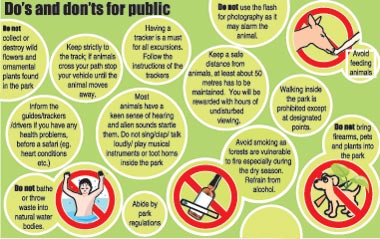What is responsible tourism with regard to elephant safaris in Minneriya and Kaudulla - two of the country’s famous hotspots for elephant gatherings?
Do we respect the animals while on safari? If not what would be the repercussions of constant irritation to animals as a result of our irresponsible behaviour inside the park? To what extent can animals tolerate this, asked Country Representative, Born Free Foundation, Dr. Deepani Jayantha during a programme to promote responsible nature tourism in Sri Lanka.
Organised in Minneriya by Jetwing Hotels in collaboration with the Born Free Foundation Sri Lanka, (a UK-based animal conservation group) the initiative focused on educating tour guides, trackers, jeep drivers in Minneriya and Kaudulla on the damage done to wildlife as a result of their irresponsible behaviour. The programme emphasised the role that can be played by each stakeholder, including the public in treating animals in an ethical way.
 |
| Exchange of views: Participants at the seminar. |
The Minneriya season from July/August to December sees a huge influx of visitors both locals and tourists to the Minneriya park. There is a resident population of about 200 elephants in Minneriya but in the dry months elephants migrate to Minneriya tank from areas like Wasgamuwa, increasing the number to about 500.
Trackers and jeep drivers who participated in the seminar also voiced their opinions on their role in the park.
Chandana Senarathne, a tracker for the past nine years said tour guides try to convince jeep drivers to go off the track or get close to animals as their main concern is customer satisfaction. Drivers and guides maintain a good rapport with each other as their income depends on the other.
“Drivers try to please the guide who gives them business and the guide’s main concern is to satisfy the client. “Some travellers are hard to please; some insist on seeing more and more elephants, some do not like it when trackers get into vehicles; others try to get down in places other than the designated locations. These things result in arguments, but we try as much as possible to explain to them and follow the guidelines,” he told the Sunday Times.
It is mostly locals who tend to violate guidelines rather than tourists, the trackers added.
Dr. Deepani stressed the importance of maintaining a distance from the animals. “The wild animals’ temperament should not be underestimated. Incidents of elephants attacking the visitors have been reported.
 |
| Dr. Deepani |
There is a degree of risk involved if animals are continuously irritated,” she says.
The visitors have a vital role to play, she emphasises. Guides/trackers tend to violate guidelines because visitors try to convince them to. If a visitor can behave in a responsible way, these things can be avoided.
A Department of Wild Life Conservation official said park wardens are instructed to deploy field officers to conduct spot checks on a regular basis. Inside the park it is the tracker, who has the authority to see to it that visitors do not violate park ethics.
Trackers are not permanent employees but volunteers who are paid a daily allowance. “If they do not control their tour group, we cancel the licence of the tracker /or we suspend/dismiss jeep driver from entering the park,” the official explained citing a recent incident where a tracker and jeep driver were suspended for two weeks after they allowed a group of tourists to bathe in a waterway in Yala.
While tour groups are issued a permit with guidelines at the back of it when entering the park, if they do not follow the tracker’s advice during a safari, the latter is instructed to report them to the park warden. Such violators can be dealt with under the Flora and Fauna Protection Ordinance, she added.
|




